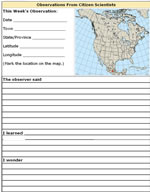Monarchs can only survive in places where their needs are being met. Where are monarchs finding the food, water and shelter they need? Look for examples. Can you find ways that people are helping?
For Your Journal: Each week, choose your favorite monarch sighting and record your thoughts in your journal. >>
Observations from Citizen Scientists
Oct.
2 Hamline, Texas
(33 N, -100 N)
The Monarchs have stopped in my backyard for about 15 years. They arrived
on Thursday this week in full force. They were hanging upside down in
my redbud tree and crepe myrtles. After dark, we kept hearing a strange
noise and realized that they were hitting the window in our bedroom, trying
to get inside the lamp that was on in my bedroom. I couldn't believe how
hard they were hitting the window! I turned off the lights and watched
TV in the dark so they wouldn't hurt themselves. The next day, I thought
they would be gone, but most of them are still here.
Oct.
4, Vernon, Texas (34 N, -99 N)
We had thousands circling round and round our tennis court. We had sprinkler
on low in our crape myrtle trees and they were flitting in it and sitting
on the little limbs. Our cat was on the tennis court crying and crying
and when we went to see about her, there must have been thousands of butterflies
swirling around her. We have a picture of 17 or 18 on one tiny twig. This
was on Saturday. Sunday we had very few. We saw them this way about 5
or so years ago, but never this many since then.
Oct.
5 Sanger, Texas
(33 N, -97 N)
Observed several hundred monarchs on the north side of trees (where they
were out of the south wind), a few flying to yellow flowers.
Oct.
4 Frederick OK (34 N, -99 N)
Hundreds of Monarchs flocking around the lawn sprinklers, roosting
in the pecan trees and settling in the English ivy ground cover in our
yard. People driving by and passing pedestrians would stop and look at
the sight. Absolutely beautiful! It was amazing how they were able to
fly against such strong winds.
Oct.
5, Kingfisher, OK (36 N, -98 N)
Wave 2- Unbelievable! 1,000-1,500 Monarchs found NE of
town roosting and nectaring in a stand of old trees and crownbeard. Everywhere
we walked flushed out 25-50 Monarchs. The wind has been blowing from the
south since Friday. The Monarchs have been stalled here due to
the strong southerly winds. The winds will change back to the
north on Tuesday, and should send them on to Texas. Such a joy to see
so many Monarchs in one place, but I'm sure the strong winds have been
hard on them. Golden crownbeard is very vital for the Monarchs in Oklahoma
this time of the year, when so much other vegetation is past its prime.
Can
you find others?
Look for more examples of food, water, and shelter monarchs need (and
find) during migration.
- You can find all observations reported this week in the sightings database and on the migration maps.
|
An
Oklahoma Favorite
|

